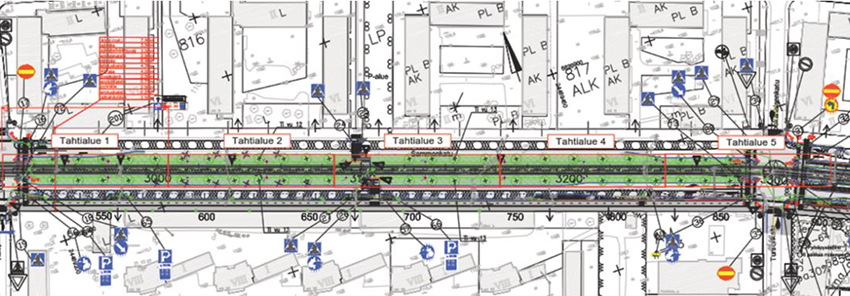Sustainable data centers as a service
- Traffic
- Construction
- Rails, roads, bridges
- 10/8/2020
Thesis: takt time production suits the construction of tramway substructures and superstructures
In this case study of takt time production, the lead time of one project stage in a tramway construction project was reduced by 60% compared to unbalanced production.

Low productivity is a long-term problem in the construction industry, resulting in long lead times in projects. The production control methods used in construction have remained unchanged in spite of construction having become increasingly complex due to the impact of the digitalisation of designs, new technical disciplines and the alignment of various stakeholder interests.
Lean methods are used to improve the efficiency of production in construction to reduce lead times. Takt time production, which has recently become increasingly widely used in the construction industry, has received a lot of attention in various communities in the construction industry and it is seen as a solution to the problems caused by low productivity. While takt time production has already been piloted at YIT’s housing construction sites, it is still a new approach in infrastructure projects.
Takt time enhances production smoothly
Creating a continuous flow in production addresses productivity problems by eliminating waste, or non-value-adding activities, from processes. Flow in production refers to a continuous process in which all stages proceed sequentially, in a controlled manner, from one task to the next.
In flow production, the use of resources is balanced across tasks and incomplete production is minimised. Takt time production utilises flow to create a smooth production process in which recurring steps take place in a continuous flow, by takt area, in takt time blocks of equal duration. This means that the rate of performance in all production sub-processes is balanced.
The takt time approach has not been previously piloted or used in tramway construction.
The aim of my thesis was to examine the suitability of takt time production for the production planning and control of an infrastructure project. The thesis investigates the conditions for adopting takt time production as well as the challenges and opportunities involved. In the thesis, I also examined the suitability of takt time production to an already completed street section of the Tramway Alliance project as a case study and discussed the management practices and routines suitable for production control in takt time production.

Challenges in tramway construction
In the thesis, I identify a number of challenges associated with takt time production, some of which are unique to traffic infrastructure projects. This suggests that takt time production is not ideal for all construction stages and environments.
Especially in densely built urban environments, the problems faced during construction operations include limited space and unpredictable soil conditions. One of the biggest problems of takt time production is considered to be variation, or the lack of repetition, in tramway construction. Identifying repetitive stages in construction processes is also seen as a challenge.
Takt time production is best suited for modular construction with minimal variation and a high degree of repetition. Other challenges identified in the case study included the unfamiliarity of takt time production and a lack of commitment to takt time production due to resistance to change.
Opportunities and concrete methods
In spite of the challenges, takt time production also presents significant opportunities and there are concrete methods for promoting its implementation. The implementation of takt time production should take place gradually, using practice timing and piloting. The construction process should be familiar to the site personnel and the production planning should be based on realistic rates of productivity.
The efficiency of takt time production can be improved by implementing appropriate changes in contract management, day-to-day management and logistics. Takt time production can be used to achieve reductions in construction lead times at least in individual construction stages and street sections. In addition to the cost savings derived from a more condensed schedule, reduced lead times also have other benefits, such as the improved public image and acceptance of the project, the easier organisation of work, smoother work and making the work more meaningful and rewarding.
Takt time production suits tramway construction projects
In my thesis based on a case study, I show how takt planning in accordance with takt time production can be implemented. In the case study, takt planning was applied to one stage of construction, namely the construction of the tramway substructures and superstructures for one street section.
The solution model provides proof that takt time production suits the construction of tramway substructures and superstructures.
Substructure and superstructure construction is characterised by relatively low variation, which makes takt planning feasible for long street sections with a sufficient degree of continuity. Creating the work phases is possible thanks to resources specialising in particular tasks, which makes the process logically pull-driven.
The balancing of tasks is the most challenging stage of takt planning. Resource utilisation needs to be based on the technical aspects of implementation to enable takt time production. In this case study, balancing production reduced the lead time by 60% compared to unbalanced production.
 Veetu Helkiö / Site Supervisor
Veetu Helkiö / Site Supervisor
Applicability of takt production in production planning of a tramway project (FI)



